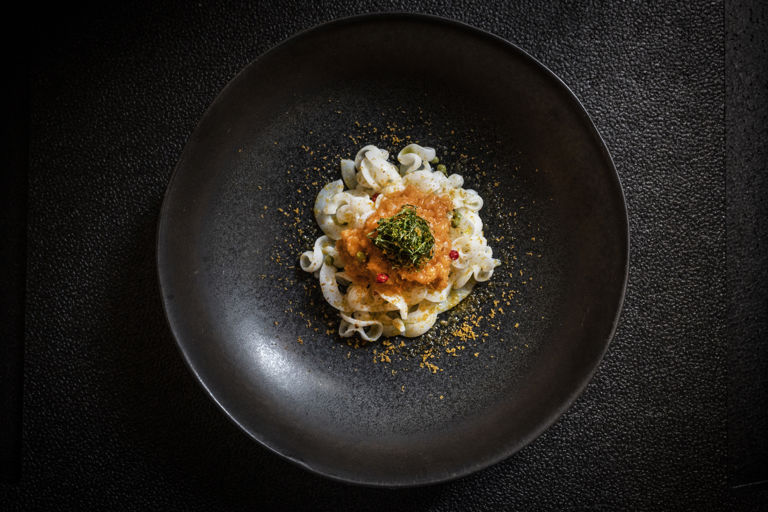Cornish squid 'Bolognese'

- medium
- 4
- 45 minutes
Japanese ingredients and techniques are given an Italian twist in this intriguing, light squid dish from Masaki Sugisaki. The squid 'pasta' is briefly cooked in an intense dashi, before being topped with a miso-rich tomato and squid sauce with peppercorns, shiso and bottarga each adding their own unique flavours. It's a wonderful, playful, light dish that's like nothing you've ever tasted before.
First published in 2021
Ingredients
Metric
Imperial
Squid pasta
- 280g of squid, main body only, skinned and cleaned
- 10g of extra virgin olive oil, plus extra for drizzling and frying
- 2g of Maldon salt
Squid Bolognese
- 200g of squid, wings and tentacles only, skinned and cleaned
- 5g of tomato purée
- 80g of sake
- 50g of saikyo miso, (white miso)
- 5g of soy sauce, ideally tsukuri soy
Koi-dashi
- 1l filtered water
- 15g of kombu
- 10g of dried shiitake mushrooms
- 18g of bonito flakes
- 8g of light soy sauce
- 5g of Maldon salt
- 15g of sake
To serve
- shiso leaves, finely julienned
- 1 slice of bottarga, ideally toasted over charcoal
- 1 pinch of pink peppercorns
- 1 pinch of sanshō
SAVE RECIPE
Method
1
Begin by making the koi-dashi, as this takes several hours to infuse and can be made ahead. Lightly rinse the shiitake mushrooms under running water, then leave to soak in warm water for 5 minutes
- 10g of dried shiitake mushrooms
2
Lightly clean the surface of the kombu with a damp cloth, ensuring you don’t brush away the white residue on the surface of the seaweed. Drain and rinse the soaked mushrooms, then place the mushrooms, kombu and filtered water in a pan or, if you have a vacuum sealer, seal in a bag. Set aside to infuse for 3 hours at room temperature
- 15g of kombu
- 1l filtered water
3
After 3 hours, you need to gently heat the dashi at 60-65°C for 1.5 hours – this can either be done using sous vide if you have the equipment, or in a lidded pan using a temperature probe
4
After 1.5 hours at 60-65°C, strain the dashi into a clean pan and bring to 85°C. Add the bonito flakes, turn off the heat, briefly stir the bonito for around 1 minute, then gently pass the dashi through muslin cloth or a very fine sieve
- 18g of bonito flakes
5
Bring the dashi to the boil, then add the soy and salt. Gently stir until the salt dissolves, then add the sake. Remove from the heat and set aside until needed
- 8g of light soy sauce
- 5g of Maldon salt
- 15g of sake
6
To prepare the squid pasta, finely slice the squid into thin ribbons. Dress with the olive oil and a pinch of salt, then set aside at room temperature
- 280g of squid, main body only, skinned and cleaned
- 10g of extra virgin olive oil, plus extra for drizzling and frying
- 2g of Maldon salt
7
For the squid Bolognese, take the wings and slice into ribbons once more, then cut at a 90° angle and slice again, to create a very small dice. Cut the tentacles into a similar shape, then use the heel of your knife to cut them even finer
- 200g of squid, wings and tentacles only, skinned and cleaned
8
Place a saucepan over a low-medium heat and add a drizzle of olive oil. Add the diced squid and tentacles, then cook until the squid releases its water and the liquid evaporates. Add the tomato purée, then cook for a further few minutes until well combined
- 5g of tomato purée
9
Add the sake and simmer for a few minutes over a higher heat until the alcohol evaporates, then add the miso. Stir until the miso dissolves into the sauce, then season with soy. Set aside and keep warm
- 80g of sake
- 50g of saikyo miso, (white miso)
- 5g of soy sauce, ideally tsukuri soy
10
Bring the seasoned koi-dashi to just below simmering point, then add the squid pasta ribbons. Stir with chopsticks, and as soon as the squid curls up take it out of the liquid (this will take less than 1 minute)
11
To serve, place the squid pasta in the middle of each bowl. Add a spoonful of the sauce, then drizzle with olive oil. Finish with the julienned shiso leaf, scatter over a few pink and sansho peppercorns, then finely grate over the bottarga
- shiso leaves, finely julienned
- 1 slice of bottarga, ideally toasted over charcoal
- 1 pinch of pink peppercorns
- 1 pinch of sanshō
First published in 2021
Get in touch
Please sign in or register to send a comment to Great British Chefs.

